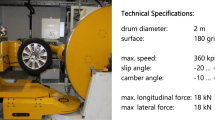Abstract
This study presents a method for developing a tire indoor wear test mode that reflects road driving conditions using a Flat-trac. Using a machine learning model, the slip angle, slip ratio, longitudinal force, and lateral force change according to vehicle speed and acceleration changes are estimated. Reduced data representing the estimated data are calculated using a peak–valley (PV) algorithm. Through the blocking process, representative test modes for driving and braking, right turning and left turning are derived and converted into a test mode for application to the Flat-trac. The evolution of tire tread wear is observed through 120 repeated tests, and the applicability of the test mode developed in this study is discussed.















Similar content being viewed by others
Data Availability
The data that support the findings of this study are not available due to manufacturer's request.
References
AIR5797. (2013). Aircraft tire wear profile development and execution for laboratory testing. SAE International.
Gadola, M., Chindamo, D., Romano, M., & Padula, F. (2014). Development and validation of a Kalman filter-based model for vehicle slip angle estimation. Vehicle System Dynamics, 52(1), 68–84.
Gipser, M. (2005). FTire : A physically based application-oriented tyre model for use with detailed MBS and finite-element suspension models. Vehicle System Dynamics, 43(sup1), 76–91.
Gultlinger, J., Gauterin, F., Brandau, C., Schlittenhard, J., & Wies, B. (2014). Investigations of road wear caused by studded tires. Tire Science and Technology, 42(1), 2–15.
Herbert, A., & Fischer, G. (2004). Load program development and testing of super single wheels in the biaxle wheel test rig and numerical pre-design. SAE Technical paper.
ISO. (2018). ISO 28580:2009(E), Passenger car, truck and bus tyres - methods of measuring rolling resistance - single point test and correlation of measurement results
Jeong, D., Lee, J., Choi, S., Kim, M. (2018). Tire load estimation using intelligent tire with accelerometer, in Proceedings of the Korean Society of Automotive Engineers - Daejeon/Sejong/Chungcheong branch, pp. 6–9.
Jian, K., Yang, D., Xie, S., Xiao, Z., Victorino, A., & Charara, A. (2019). Real-time estimation and prediction of tire forces using digital map for driving risk assessment. Transportation Research Part C, 107, 463–489.
Jung, S., & Jo, J. (2018). Test method of rolling resistance of a tire considering cornering condition. Transactions of the Korean Society of Automotive Engineers, 26(6), 736–744.
Knisley, S. (2002). A correlation between rolling tire contact friction energy and indoor tread wear. Tire Science and Technology, 30(2), 83–89.
Mathissen, M., Grochwicz, J., Schmidt, C., Vogt, R., Hagen, F., Grabiec, T., Steven, H., & Grigoratos, T. (2018). A novel real-world braking cycle for studying brake wear particle emissions. Wear, 414–415, 219–226.
Matsuzaki, R., Hiraoka, N., Todoroki, A., & Mizutani, Y. (2012). Strain monitoring and applied load estimation for the development of intelligent tires using a single wireless CCD camera. Journal of Solid Mechanics and Materials Engineering, 6(9), 935–949.
Nopiah, Z., Khairir, M., Abdullah, S., & Nizwan, C. (2008). Peak-valley segmentation algorithm for fatigue time series data. Wseas Transactions on Mathematics, 7(12), 698–707.
Nurkala, L., & Wallace, R. (2004). Development of the SAE biaxial wheel test load file. SAE Technical paper.
Pacejka, H., & Bakker, E. (1992). The magic formula tyre model. Vehicle System Dynamics, 21(sup1), 1–18.
Quddus, M., & Washington, S. (2015). Shortest path and vehicle trajectory aided map-matching for low frequency GPS data. Transportation Research Part C, 55, 328–339.
Ray, L. (1997). Nonlinear tire force estimation and road friction identification: Simulation and experiments. Automatica, 33(10), 1819–1833.
Scikit-learn, Regression, (2022). https://scikit-learn.org/stable/supervised_learning.html#supervised-learning. Accessed 10 Oct 2022.
Seo, Y., Kwak, S., Lee, L., Lee, H., Liu, H., Jo, H., Park, S., & Lee, E. (2018). Vehicle load measurement using tire deformation values. Journal of Korean Institute of Intelligent Systems, 28(2), 170–176.
Seo, Y., Kwak, S., & Yang, J. (2021). Tire speed measurement using strain gauge sensor. Journal of Korean Institute of Intelligent Systems, 13(5), 376–382.
Singh, K., & Taheri, S. (2019). Accelerometer based method for tire load and slip angle estimation. Vibration, 2, 174–186.
Smith, K., Kennedy, R., & Knisley, S. (2008). Prediction of tire profile wear by steady-state FEM. Tire Science and Technology, 36(4), 290–303.
Snoek, J., Larochelle, H., & Adams, R. (2012). Practical Bayesian optimization of machine learning algorithms. Advances in Neural Information Processing Systems, 25, 1–9.
Stalnaker, D., & Turner, J. (2002). Vehicle and course characterization process for indoor tire wear simulation. Tire Science and Technology, 30(2), 100–121.
Stalnaker, D., Turner, J., Parekh, D., Whittle, B., & Norton, R. (1996). Indoor simulation of tire wear: Some case studies. Tire Science and Technology, 24(2), 94–118.
UN/ECE. (2008). UNECE Regulation No. 30, uniform provisions concerning the approval of pneumatic tyres for motor vehicles and their trailers.
Wilkin, M., Manning, W., Crolla, D., & Levesley, M. (2006). Use of an extended Kalman filter as a robust tyre force estimator. Vehicle System Dynamics, 44(sup1), 50–59.
Acknowledgements
This study was supported by the Ministry of Trade, Industry, and Energy and the Korea Evaluation Institute of Industrial Technology (KEIT) in 2021 (20015841, sustainable material-based eco-friendly tire-manufacturing technology development).
Author information
Authors and Affiliations
Corresponding author
Ethics declarations
Conflict of Interest
All authors declare that they have no conflicts of interest.
Additional information
Publisher's Note
Springer Nature remains neutral with regard to jurisdictional claims in published maps and institutional affiliations.
Rights and permissions
Springer Nature or its licensor (e.g. a society or other partner) holds exclusive rights to this article under a publishing agreement with the author(s) or other rightsholder(s); author self-archiving of the accepted manuscript version of this article is solely governed by the terms of such publishing agreement and applicable law.
About this article
Cite this article
Jung, S., Lee, J. Development of Indoor Wear Test Method for Passenger Car Tires Reflecting Road Driving Conditions. Int.J Automot. Technol. 25, 413–425 (2024). https://doi.org/10.1007/s12239-024-00034-6
Received:
Revised:
Accepted:
Published:
Issue Date:
DOI: https://doi.org/10.1007/s12239-024-00034-6




